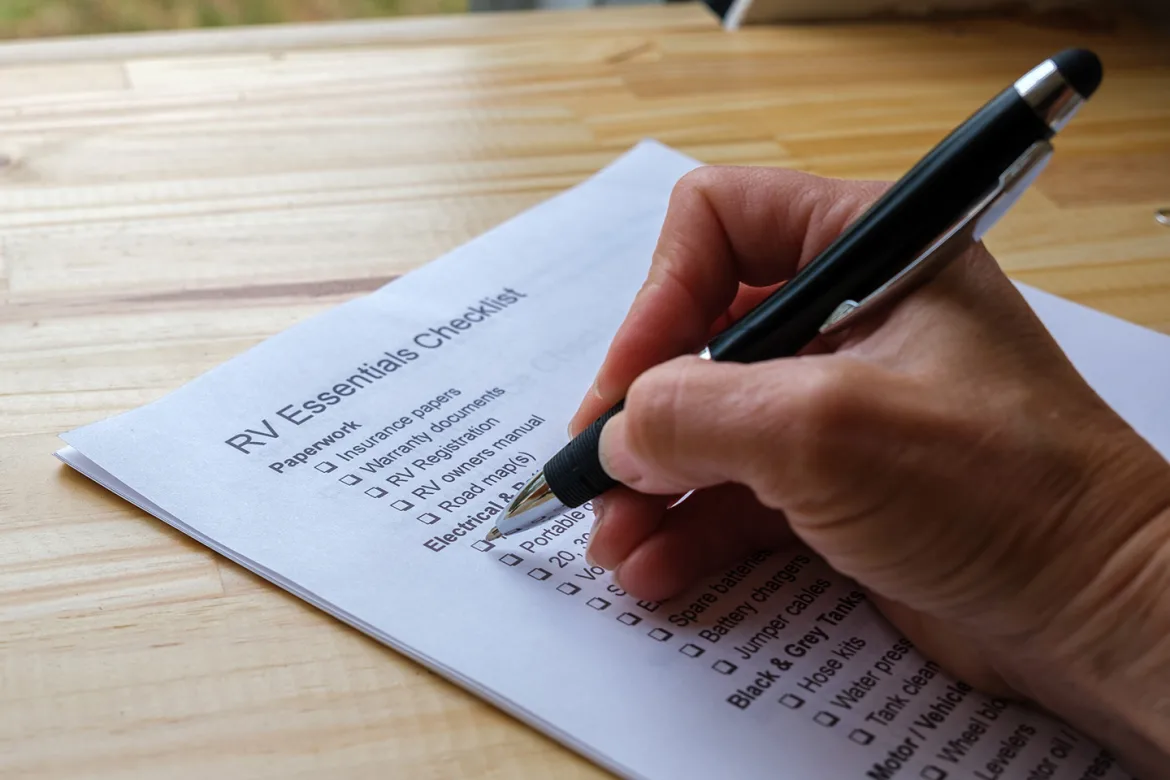By Steve Froese, F276276
I often refer to the importance of good habits and regular RV maintenance in my articles. Let’s take a closer look at what that means for owners of motorhomes and towable RVs in terms of pretrip and annual maintenance requirements.
Pretrip
Pretrip inspections should be performed prior to any travel, whether you are pulling out of your driveway or leaving a campsite. An often-overlooked issue is that of vehicle insurance. You’ll want to make sure your insurance is up to date and carry copies of the insurance papers with you. Check that your vehicle registration and license are current also.
If you’re towing a travel trailer or driving a motorhome that is pulling a towed vehicle, check and double-check the hitch connections to make sure they are secure. Check the wiring harness and the lights as well.
By the way, it is a good idea to stop and inspect the towed vehicle shortly after starting your drive. This is especially important if you are towing a vehicle using a dolly, as rigging can come loose after a few miles. I generally check my tow dolly and towed car after a few right and left turns; this tends to be what causes the vehicle’s wheels to shift slightly on the dolly, requiring retightening of the straps. However, something could come loose on any towed vehicle or trailer after a few miles, so this kind of check is a good idea in general. Some towing configurations may require more frequent inspections, such as at every highway rest stop.
Speaking of rest areas, make good use of them. Do not drive while tired, anxious, stressed, etc., and don’t drive more hours than you are comfortable with. Plan your trips to avoid this. RV travel is all about relaxed leisure time, so leave plenty of travel time in your itinerary. Utilizing a rest area for a few hours of shut-eye is a good way to refresh. Do not overstay your welcome; make sure you know the maximum time allowed at a rest stop. This varies by state or province.
Continuing the pretrip prep, turn off all appliances and propane container(s) — but also check the propane level in case you need to refill. Ensure that all exterior doors, windows, vents, and hatches are closed and secured. Make sure awnings, slideouts, and steps are fully retracted. Lower the TV antenna, an oft-neglected step.
Securely stow all loose items and make sure all cabinet and cupboard doors are fully closed. Don’t forget to latch the shower door, if applicable.
Make sure to disconnect and stow fresh-water and waste-water hoses, power cables, and any other items unpacked during travel.
Check all exterior lights, as well as tire pressures and condition. Tire pressure should be checked when the tires are cold, so this is best done before you head out for a day of travel. While it is outside the scope of this article to describe the process, it is a good idea to have your RV weighed so you know the appropriate tire inflation pressures. The pressure noted on the tire sidewall is the maximum inflation pressure, but it is rarely the right running pressure for your RV. Refer to the tire manufacturer’s website for inflation pressure based on actual weights. Check the tread and overall tire condition. If you see any questionable wear or damage to the tires, have them professionally inspected at a tire shop. RV tires usually age out before they wear out, unlike car tires.
Perform a thorough walk-around of your entire RV prior to driving, looking for any potential hazards or obstacles, items left behind, and people or animals in your path. In the case of an RV with a built-in ladder, I recommend a quick inspection of the roof, which will also provide a view of overhead hazards. Determine your travel path, especially if maneuvering might be tricky. Assign a spotter if necessary or if in doubt.
Maintenance
While most RV maintenance is performed on a yearly basis, some should be done on an as-needed basis.
I have shared several articles about annual maintenance in Family RVing magazine and elsewhere, so here I will discuss items that should be checked more regularly, such as monthly or while the vehicle is in storage. It goes without saying that you should be on the lookout for anything that requires maintenance or repair during your travels. Some issues will require immediate attention, while others can wait until your annual dealership visit or next DIY opportunity.
Regularly check the condition of your house batteries. Make sure they are clean and dry and free of battery acid, which tends to accumulate on the terminals. You can use an old toothbrush and a simple solution of water and baking soda to remove battery acid. If the battery is not maintenance-free, check the electrolyte level once per month, especially if the RV is plugged in to shore power, as the electrolyte will boil off over time.
Keep an eye on the exterior sealants of the RV, including those on the roof. Any significant cracks or damage should be addressed as soon as possible; minor cracks and wear can wait for the yearly checkup.
Check the RV roof regularly for damage, including the condition of the membrane, and look for any cracked or damaged vents, skylights, A/C covers, etc. It is easy for undetected roof damage to lead to major issues with water leaks and the like.
In time, you will learn the intricacies of your RV such that you will come to know if you need to watch for additional issues.

